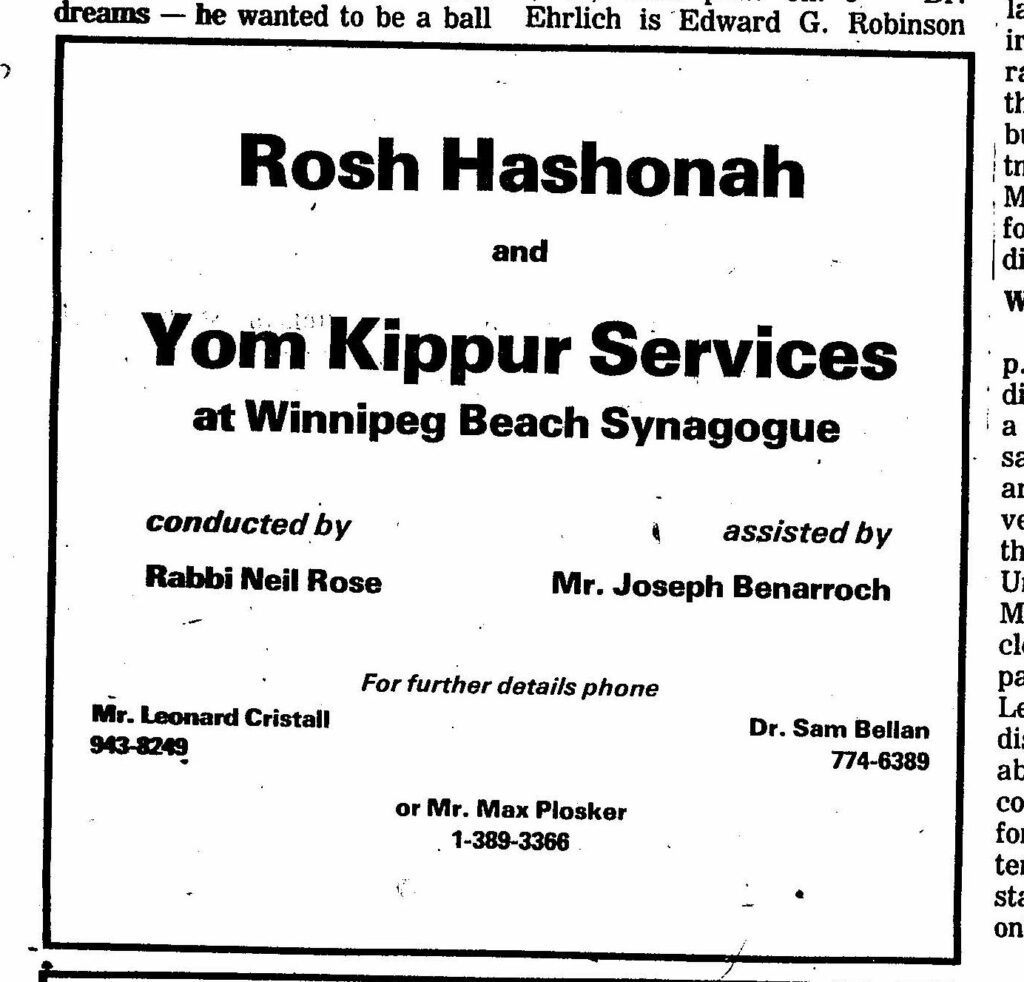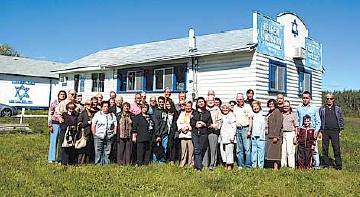Features
History of the Winnipeg Beach Synagogue: 1950-2025

By BERNIE BELLAN The history of the Winnipeg Beach Synagogue is a fascinating one. We have had several articles over the years about the synagogue in The Jewish Post & News.


In June 2010 I wrote an article for The Jewish Post & News upon the 60th anniversary of the synagogue’s opening. Here are the opening paragraphs from that article:
“Sixty years ago a group of Winnipeg Beach vacationers decided that what their vacation area lacked was a synagogue. As it happened, a log cabin one-room schoolhouse in the Beausejour area happened to be available.
“In due course, the log cabin was relocated to the corner of Hazel and Grove in Winnipeg Beach, where it stayed for 48 years.”

In December 1994 my late brother, Matt, wrote a story about the spraying of antisemitic grafitti on the synagogue which, at that time, was still situated at its original location on the corner of Hazel and Grove in the town of Winnipeg Beach:
“Two 16-year-olds spraypainted slogans like ‘Die Jews,’ ‘I’ll kill you Jews,’ and other grafitti in big letters on the beach synagogue.
“Jim Mosher, a news reporter for the Interlake Spectator in Gimli, said last Halloween’s vandalism against the synagogue wasn’t the first. In the late 1980s, he claimed, it was spraypainted with swastikas.
“Jack Markson, a longtime member of the Winnipeg Beach Synagogue, last week also said he could remember finding anti-Semitic grafitti spraypainted on the synagogue ‘a few years ago,’ and at least twice in the 1970s, when the cottage season was over.”

My 2010 article continued: “In 1998 the Town of Winnipeg Beach informed the members of the synagogue that the building would have to be hooked up to the town’s sewer and water system. Rather than incur the cost of $3-4,000, which was thought to be ‘prohibitive,’ according to longtime beach synagogue attendee Laurie Mainster, synagogue goers looked elsewhere for a solution.
“As a result, the board of Camp Massad was approached and asked whether the synagogue might be relocated there, with the understanding that the synagogue would be made available to the camp at any time other than what were then Friday evening and Saturday morning services.
“Over the years the ‘beach synagogue’ had come to be a very popular meeting place for summertime residents of Winnipeg Beach and Gimli. In fact, for years minyans were held twice daily, in addition to regular Saturday morning services. Of course, in those years Winnipeg Beach was also home to a kosher butcher shop.
“While the little synagogue, which measured only 18 x 24 feet, has gone through several transformations, including the move to Camp Massad, and the opening up to egalitarian services in 2007 (The move to egalitarian services was as much a practical necessity as it was a nod to the equality of women – the only Kohen present at the time was a woman!), it has always remained cramped at the best of times.

“In recent years the synagogue has seen the addition of a window airconditioner (although to benefit from it, you really have to be sitting just a few feet away), as well as a fridge that allows synagogue attendees to enjoy a regular Saturday morning Kiddush meal following the service.
“According to Laurie Mainster, the Saturday morning service has continued to be popular, even though many of the attendees now drive in from Winnipeg, as they have sold the cottages they once maintained.
“On the other hand, one of the side benefits to being located on Camp Massad’s grounds has been an infusion of young blood from among the camp counsellors.
“Since there is no longer a rabbi available to conduct services (Rabbi Weizman did lead services for years while he had a cottage at the beach), those in attendance now take turns leading the services themselves.
“Anyone may attend services and, while there are no dues collected, donations are welcome. (Donations should be made to the Jewish Foundation of Manitoba, with donors asked to specify that their donations are to be directed to the beach synagogue.)
“Mainster also says that the beach synagogue is now undergoing an expansion, which will be its first in 60 years. An entirely new space measuring 16 x 18 feet is being added – one that will allow for a real Kiddush area. (Until now, a table has been set up in the back of the synagogue and synagogue goers would help themselves to the buffet that is set up each Saturday during the summer. While pleasant enough, it will certainly be more comfortable to have an actual area set aside for the Saturday afternoon after service lunch.)
“As for dress, longtime attendee Abe Borzykowski (in an article written by Sharon Chisvin for the Free Press in 2007) remarked that ‘I don’t think there are many synagogues where people can attend in shorts, T-shirts and sandals and not feel out of place.’ “

As mentioned in that 2010 article, the beach synagogue at that time was about to undergo an extensive remodelling. Here is an article from a January 2011 issue that describes that remodelling process. The article was written by Bernie Sucharov, who has been a longtime member of the beach synagogue:
“The Hebrew Congregation of Winnipeg Beach made a major change to the synagogue this past summer. With the help of many volunteers, Joel Margolese being the project manager, the synagogue was expanded and an addition was built to handle the overflow crowds, as well as to add more space for the kiddush following services.
“The volunteers spent many Sundays during the summer months building the addition. Bad weather caused many delays, but finally the addition was completed one week before the official summer opening.
“The volunteers were: Joel Margolese, Gordon Steindel, Sheldon Koslovsky, Viktor Lewin, Harvey Zabenskie, Nestor Wowryk, Kevin Wowryk, Victor Spigelman, Jerry Pritchard, and David Bloomfield.
“On Sunday, June 25, 2010 a special ceremony was held to affix a mezzuzah to the front entrance door. Gordon Steindel had the honour of affixing the mezzuzah, which was donated by Sid Bercovich and Clarice Silver.
“Refreshments and food for the day were prepared by Phyllis Spigelman, also known as our catering manager. Throughout the summer, Phyllis, Lenore Kagan and other friends prepared the food for our kiddush.
“A sound system was donated by Arch and Brenda Honigman in memory of their father, Sam Honigman z”l. “The system was installed by Joel Margolese and Stevan Sucharov. This will allow the overflow crowd to hear the service in the new addition.
“There were also generous donations of 50 chumashim and an air conditioner. The chumashim were donated by Gwen, Sheldon and Mark Koslovsky. The air conditioner in the new addition was donated by Joel and Linda Margolese.
“The official opening of the synagogue for the summer took place on July 3, 2010. We had an overflow crowd of 70+ people.”

Since that 2010 major addition to the synagogue, it has also added a wheelchair ramp (although I’ve been unable to ascertain exactly when the ramp was built). Also, the synagogue also has its own outdoor privy now. (Attendees used to have to use facilities in Camp Massad.)
And, as already noted in article previously posted to this site (and which you can read at Beach Synagogue about to celebrate 75th anniversary), in recognition of that occasion, on August 2nd members of the synagogue will be holding a 75th anniversary celebration.
As part of the celebration anyone who is a descendant or relative of any of the original members of the first executive committee is invited to attend the synagogue that morning.
If you are a relative please contact Abe Borzykowski at wpgbeachshule@shaw.ca or aborzykowski@shaw.ca to let Abe know you might be attending.
Features
“Two Weeks in Toronto” is a sweet romantic novel, but with some major shortcomings

Review by BERNIE BELLAN As the former publisher of The Jewish Post & News, but still publisher of a popular website – jewishpostandnews.ca, I’ve long been inundated with requests to review books.
I tend to ignore almost all those requests – simply because I don’t have other reviewers available who are willing to review books – unlike years past when there were a few different individuals who would be willing to review books for the paper, so it falls on me to do all the reviewing.
Something else that’s happened more and more often in recent years is that authors become their own publicists and can be quite good at drawing attention to their books.
So it was that when I was contacted a month ago by a writer by the name of Amelia Doyle, who asked me whether I’d be interested in reading a book she’d written titled “Two Weeks in Toronto,” the name of that book was familiar to me as Amelia had contacted me last year to ask me whether I’d like to review her book back then.
I did take her up on her offer at that time – and began to read “Two Weeks in Toronto” but, if truth, be told, I lost interest in it. The book had some major flaws – and as romantic fiction I thought it lacked any real spark.
But, when Amelia contacted me again, this time her email noted that the book was a finalist in something called the Canadian Book Club Awards.
Really? I thought. Maybe I was too quick to put that book down – or to turn off my Kindle – as the case may be.
So, I began to read “Two Weeks in Toronto” all over again – with a promise to myself to finish it this time.
I should also add that of the many emails I’ve been receiving in recent years, many have been either from publicists for books or from the authors themselves, and many of the books I’ve been asked to review have been self-published.
It’s not all that difficult to publish a book nowadays and, in fact, many self-published books that I have read have been quite good.
In the case of “Two Weeks in Toronto,” after opening the book again many months after I had first taken a look at it though, I saw that it was published by something called “BRINKLEY Verlag.” I did some research on BRINKLEY Verlag and saw that it’s an Austrian publishing house, but with no information on its website whether it simply publishes books for a fee or whether it actually accepts manuscripts and publishes them without charging the author.
Also, on the title page of “Two Weeks in Toronto,” it says that the book was edited by someone by the name of Kelly McErlean.
Okay – the book had been published by some sort of publishing house and apparently, it had also been edited. I regarded both those things as pluses.
One more thing: I did do some research on Amelia Doyle and saw that she has authored at least a couple of other books: “A Dublin Love Story” and “The Rabbi’s Wife,” so she must have had at least some practice writing novels, I thought. By the way, if you Google Amelia Doyle and see what books she’s written, you can see they’re all described as “sweet romance.”
What does this have to do with my reviewing the book? you must be wondering.
Well, I’ve been in correspondence with Amelia Doyle and she seems such a nice person that I told myself I have to find something good to say about “Two Weeks in Toronto.”
But honestly, I tend to look at the novels my wife likes to read for guidance as to what women like when it comes to romance and many of the titles I see have a mystery element to them – or some rip roaring sex!
Here’s what AI says when you ask it what kind of romance novels women like to read: “Most women enjoy diverse romance novels, from steamy contemporary/spicy reads and funny rom-coms (like Emily Henry) to emotional historical sagas (like Outlander) or ‘romantasy,’ but popular choices often feature strong emotional connection, relatable characters, satisfying happily ever afters’ (HEA), and tropes like enemies-to-lovers or billionaire romance, with recent trends favoring diverse voices and escapism.”
So where does “Two Weeks in Toronto” fit into any of those descriptions, if any?
Well, it does have a romance at the centre of it, but the romance is so predictable that it hardly whets the appetite.
What it does have though, and which might make it of particular interest to Jewish readers, is a female Jewish protagonist by the name of Ciara Walsh. (Ciara, I had to look up, is an Irish name, and is pronounced Kee-ara. What a nice name!)
The person with whom you just know from the outset Ciara is going to fall in love is her dreamy Irish dentist, Ethan O’Leary, tall and blue-eyed – and strange as it may seem: unattached.
At a certain point we find out that Ciara is Jewish – when Ethan comments on the mezuzah on her door, but as to how Jewish she is – well, that was something I began to wonder about as the book went on.
Now, it’s important to note that the book is set right around Christmas – and Chanukah, and the juxtaposition of those two holidays enters into the plot time and time again. There seemed to be so little distinction between the atmosphere pervading both holidays – wintertime, gift giving, family get-togethers, that I wondered whether Amelia Doyle might not be Jewish, but was trying to attract a Jewish audience by injecting some Jewish notes into her book – so I asked her this question: “Are you Jewish in any way, e.g., have some Jewish family?”
Amelia answered: I’m halachically Jewish. “Both my parents come from observant Jewish families and I grew up in a Conservative home.
“Generally speaking, you can find anything from ultra-orthodox to atheist Jews in my family. As you can imagine, living in Europe is not easy as a Jewish person. (I should note that, after further researching Amelia, I discovered that she lives in Dublin.)
“The characters in ‘Two Weeks in Toronto’ were written on purpose in a matter that is more on the liberal side as many of my friends are Reform or in interfaith marriages. This is where the inspiration for this specific book came from.”
In the same email in which I asked Amelia whether she was indeed Jewish, I also noted that I thought the way she intermingled Christmas and Chanukah was deliberately intended to “resonate” with non-Jewish readers.
Amelia responded: “I’m Jewish and there are many ways of practicing Judaism. In this book I decided to write about a non-orthodox Jewish family.”
A “non-orthodox Jewish family?” There’s not much Jewish about them, other than the fact that Ciara’s father, Ian, decided to convert to Judaism when he was younger – for reasons that are totally unexplained. Ciara’s mother, Giuliana (which, apparently, is the Italian spelling for Juliana), is definitely not Jewish, although she doesn’t seem to have much religious orientation either way.
But, let’s not get lost in what is, in essence, a discussion totally irrelevant to this book.
My qualms with “Two Weeks in Toronto” have to do with the writing style – which could have used some good editing. I mentioned that in an email to the author when I was just getting into the book. I suggested that the dialogue could have been much improved had the characters used contractions when speaking, so that for instance, instead of a character saying “I am just stepping out” they could have said, “I’m just stepping out” – which sounds so much more authentic.
Another aspect of this book that drove me crazy is there no explanation for the behaviour of Ciara’s mother, Giuliana, or her sister, Gabriella. Cinderella’s stepmother comes across as kindly compared to Giuliana and, as for Gabriella, who is occasionally referred to as “Bridezilla” by others, well – to use the Cinderella comparison again, she is beyond detestable.
But why? What on earth could sweet, loving Ciara ever have done to provoke such unbridled hatred from her mother and sister? I kept waiting to read an answer – you know, like Ciara was so beautiful that her sister despised her or Giuliana was her stepmother – but no, it’s never explained.
And then there’s Ciara’s relationship with Ethan. Yes, it’s cute how they end up going to Toronto together – to attend Gabriella’s wedding, and they end up sleeping in the same bed together – but without having sex!
So, again, I had to ask Amelia why that was? Here’s what she answered: “In my opinion, most romance books these days are far too explicit. ‘Sweet Romances’ (also known as ‘Clean Romance’) are on the rise again at the moment and this is what my publisher asked me to write.
“Personally, I prefer to have the focus on the relationship and not any sexual relations.
“Not sure about how it is in Canada, but many publishers in Europe as well as the US started publishing ‘clean’ versions of steamier books, not to alienate readers who don’t want to read sexually explicit scenes.”
I’m shattered! “Clean romances” are “on the rise again?” (There’s almost a phallic pun in there, but we won’t go there.)
But hey, it’s almost Chanukah – and Christmas. “Two Weeks in Toronto” is set right around this time of year, so maybe this review is timely. As it’s referred to in the book, this is a book that might make a good read for “Chrismuakkah.”
“Two Weeks in Toronto”
By Amelia Doyle
Published by BRINKLY Vertag, 2024
179 pages
Available on Amazon
Features
Today’s “Anti-Zionist” Propaganda was Nurtured in the Soviet Union

By HENRY SREBRNIK For centuries, Jews have been portrayed, by both religious and secular movements, as obstacles to universal order. Christian theology turned Judaism into the emblem of stubborn particularity. Modern ideologies secularized the script, making Jews stand for capitalism, communism, cosmopolitanism, or cultural decay. In the twentieth century, this logic reached its most lethal form in the fantasy of human renewal through the erasure of Jews, culminating in the Holocaust.
The twenty-first-century iteration recycles the same template in overlapping ways. Islamist movements merge “Jew,” “Zionist,” and “Israeli” into a demonic category whose elimination is a sacred duty. Parts of the Western left have reduced Israel to the very symbol of colonial domination.
What North American Jews are experiencing today, as the ideology of anti-Zionism spreads in left-of-centre spaces, looks eerily familiar to anyone who came of age in the 1970s Soviet Union. Just like antisemites battle against a fantasy of “the Jews” that exists in their own heads, the new anti-Zionists battle a “Zionism” that is conjured up by their own fevered imaginations.
Following the June 1967 war, with Israel’s victory over its Arab neighbours, who were intent on destroying the small Jewish state, anti-Zionism became a central tenet of Soviet propaganda, where “Zionism” was usually equated with self-conscious expressions of Jewishness. It was then that the antisemitic notion of Israel as an heir to Nazism and Fascism was popularized in the Soviet media.
It depicted Israel as the outpost of colonial oppression, Jews as betrayers of socialist internationalism. Soviet propagandists distorted the history of Zionism to underscore its supposedly inherent evil nature, ripping its founders and theorists out of historical context and, absurdly, presenting Zionists as the Jewish people’s greatest enemy. These “rootless cosmopolitans” were accused of corrupting socialism from within. By redefining Jews as racists, Zionism as colonialism, the Soviets handed progressives a vocabulary of virtue through which to disguise an old hatred.
In political cartoons and Soviet propaganda art, swastikas were routinely intertwined with Stars of David, and the Israeli military portrayed as resembling Nazi — and specifically SS — troops. If there is a Soviet propaganda subtext that highlights its ideological and propagandistic roots, it would be “Fascism Under a Blue Star,” the 1971 book by Evgeny Evseev, who had served as an Arabic interpreter for both Soviet leaders Nikita Khrushchev and Leonid Brezhnev. By the late 1970s, he had became one of the principal brains of the ultranationalist antisemitic movement in the USSR, know as the “Russian Party.”
Evseev’s book carried a subtitle redolent of Marxist clichés: “Truth about contemporary Zionism: Its ideology, practice, and the organizational system of major Jewish bourgeoisie.” On the illustration printed next to the title page, there was a black spider with both a swastika and a Star of David on top of its body; the spider’s web was spread over the West, from the United States to Britain, France and Italy.
Perhaps the vilest of all these tracts was “Caution: Zionism! Essays on the Ideology, Organisation and Practice of Zionism,” a 1970 attack by Yuri Ivanov. (By the way, it was republished by a left-wing group, The November 8th Publishing House, in Toronto in 2024.) The book’s singular achievement was to fit classic antisemitic conspiracy theory into the only philosophical framework permitted in the USSR — the Marxist-Leninist one — and rewrite it as anti-Zionist critique.
“Ivanov managed to supply a strong theoretical foundation for openly criticizing Zionism with the help of Marx’s and Lenin’s works, which no one could argue against,” Vladimir Bolshakov, another prominent “Zionologist,” recalled in his memoirs. I remember coming across it in the late 1970s while writing my PhD dissertation on Jews and Communists, and was shocked by its vituperative language and tone, not to mention falsehoods, worthy of the worst Nazi propaganda.
All of this bore terrible political fruit. On November 10, 1975, the United Nations passed General Assembly Resolution 3379, equating Zionism with racism. It remains the foundation stone of antisemitic anti-Zionism. It cast Israel, the collective Jew, as committing today’s ultimate crime. Despite being mass-murdered by Nazi racists, Jews became racists. And despite enduring history’s largest genocide, Jews are now accused of “genocide.”
Communist propagandists enjoyed manipulating words to trigger “Pavlovian” responses, the Princeton Kremlinologist Robert Tucker observed; their “ultimate weapon of political control would be the dictionary.”
Much has been written of late about the deep Soviet roots of today’s virulent anti-Zionism in the West. Some thirty-five years after the fall of the Soviet empire, the Soviet corpse continues to emit its infectious gases and poisons people’s minds and imaginations. After 7 October, parts of the Western Left responded not with horror but with slogans lifted from Soviet propaganda: Israel as colonial, Zionism as apartheid, Jews as global oppressors.
Today’s anti-Zionism is not actually concerned with the relationship Jews have with Israel. It is a project centered on producing villains. In this, it follows its predecessors: antisemitism and anti-Judaism. Antisemites were never concerned with the authenticity of Jewish identity, practice, or behaviour; they sought to construct “the Jew” as a monster.
Anti-Zionism repeats this mechanism, simply substituting “the Zionist” for “the Jew,” while inheriting the same foundational hatred. Failing to recognize that anti-Zionism, whose Soviet and Nazi genealogy reveals that it has nothing to do with Jews and their right to self-determination, is fundamentally a project of constructing fiends.
Antisemitism functions not merely as a prejudice but as a moral language, a grammar that shapes how societies explain disorder and assign blame. It provides simplicity where reality is complex and coherence where the world feels incoherent. For such people, it becomes a battle against a uniquely devious and implacable foe – something that cannot be resolved by elections or arguments, but only by confrontation. The logic points beyond persuasion to elimination.
The only way to be anti-Zionist without being an antisemite is to reject the legitimacy of all nation-states equally. The loudest supporters of Palestinian statehood are not doing that. No one should mistake it, or be taken in by those espousing it, for what it is. We should call it, along with antisemitism and anti-Judaism, as “Jew-hatred.” It is nothing more – or less.
Henry Srebrnik is a professor of political science at the University of Prince Edward Island.
Features
“Kaplan’s Plot” – newly released novel set in Chicago is both historical fiction and psychological drama

Reviewed by BERNIE BELLAN I had been searching for a new book this summer that would be of particular interest to Jewish Post readers when I came across the title of a new book that had yet to be released, called “Kaplan’s Plot.” It had received quite a bit of buzz on a number of websites that spotlight books that have – at least in part – a Jewish theme, although it still had not been reviewed when I first read about it.
The plot of the book, as it was described in those initial previews, certainly appealed to me, as it was said to combine a story about a Jewish gangster in Chicago in the early part of the 20th century with a modern day story about a man whose life had come completely unravelled and who was forced to return to Chicago to live with his dying mother.
I’ve been a fan of Jewish gangster stories for years, especially ones written by our own Allan Levine – and I’d often published stories about real life Jewish gangsters – or Jewish gangster fighters – as the case may be, in the pages of The Jewish Post & News (also on jewishpostandnews.ca).
Last year, for instance, I wrote a review of a book called “The Incorruptibles,” about efforts by law-abiding Jews in New York City in the early part of the 20th century to fight corruption. You can read my review here: “The Incorruptibles.”
Also, in the past I’ve run stories about Jewish underworld figures who either lived in Winnipeg or had a strong Winnipeg connection. One of the most popular stories ever to appear on our website, for instance (and which is still being widely viewed), is one that was written by Bill Redekopp – a former writer for the Free Press, who had profiled a fascinating Winnipeg bootlegger by the name of Bill Wolchock in his book, “Crimes of the Century – Manitoba’s Most Notorious True Crimes.” You can read Redekopp’s story about Wolchock at “Bill Wolchock.”
Another story that garnered quite a bit of attention when it was first published was Martin Zeilig’s story about Winnipeg-born Al Smiley, which appeared in the March 29, 2017 issue of The Jewish Post & News. The most interesting tidibt in Martin’s story was that Smiley was was sitting beside the notorious Benjamin “Bugsy” Siegel when Siegel was murdered in 1947. That story doesn’t appear as a stand-alone story on our website, but you can find it by downloading the entire March 29, 2017 issue by entering a search through our “Search archive” link for Al Smiley.
One more story that dealt with Manitoba Jewish gangsters (and which also referenced the Bill Wolchock story) was one I wrote in 2023 titled “A deep dive into the lives of some shadier members of our community.” In that story I wrote about a book that was about to be published titled “Jukebox Empire: The Mob and the Dark Side of the American Dream.” It was the story of Wolf Rabin (born William “Wolfe” Rabinovitch), written by his nephew, David Rabinovitch.
All this serves as a very long winded preamble to a review of “Kaplan’s Plot.” I was somewhat disappointed to learn that the characters in the book are all fictitious, since the mobsters are so vividly drawn – although there are very brief references to real-life mobsters, including Al Capone, Meyer Lansky and Charles “Lucky” Luciano, that make you wonder whether some of the other mobsters might also have been real people.
According to information available about the author, Jason Diamond, this is his very first novel – a very impressive debut. He certainly brings to life a very nasty Chicago in the early part of the 20th century.
What makes what Diamond has written an even more admirable achievement is that the plot works both as a riveting mystery and as a thoughtful examination of a mother and son relationship.
The story alternates between a story set in modern day Chicago (in 2023) and another story that begins in Odesa in Ukraine in 1909, but soon moves to Chicago shortly thereafter.
At first, we read about a character by the name of Elijah Mendes, who has just returned to Chicago from the Bay area, where a business venture in which he was involved has collapsed. Elijah’s mother, Eve, is dying from cancer, but she certainly retains enough strength to carry on with quite a few activities – enabled by her constant puffing on a vape pen. Eve, it turns out, has been a very accomplished poetess during her life and, although she and her late husband Peter were financially quite comfortable, she scoffs at what she regards as Elijah’s obsession with material pursuits.
Eve doesn’t pay much attention to mundane day to day matters, including opening the mail, but when Elijah discovers a series of letters from something called the Hebrew Benevolent Society, his curiosity is piqued and he sets out do discover what those letters are all about.
The chapters alternate between modern and older Chicago, as we are introduced to the Kaplan brothers – Yitzhak and Solomon or, as they come to be known in America – Itz and Sol. The brothers have narrowly escaped a pogrom in Odesa when their parents were able to secure passage for them on a boat destined for Hamburg. Eventually they find themselves on a ship sailing to America, where they make the acquaintance of a character by the name of Hershey.
Hershey tells the boys that he can help them find a place to live in Chicago, where he introduces them to Avi who, it turns out, is a major figure in the Jewish underworld there.
Diamond provides a rich description of what life was like in Chicago back in the day when the city was divided among different ethnic groups who held sway over their own respective territories and when it was dangerous to cross over into the wrong part of town.
As the story develops, we learn that Elijah is actually the grandson of Itz Kaplan, but knows nothing about his grandfather’s very shady past – beyond having been told that he was a “businessman.” When he goes to the building housing the Hebrew Benevolent Society, however, he finds out that there is an entirely new aspect to his family’s past – which leads to his wanting to probe deeply into his family’s history.
Elijah’s own demons – including past drug addiction, a failed marriage, and a deep insecurity about his own ability to succeed in business, come to the fore, but his mother’s refusal to discuss her family’s history haunts him even further.
As the book moves in parallel tracks between two time periods we find out more about Itz Kaplan – and just how malevolent a character he was. And, at the same time as Elijah learns more about Itz, he begins to better understand why his relationship with his mother had gone off the rails.
The mystery of what happened to Itz’s brother, Sol, about whom Elijah had not even known had existed, figures into both stories – the one set in early 20th century Chicago, and the one set in modern Chicago, as Elijah tries to get his mother to open up about her family.
Jason Diamond provides wonderful descriptions of some of the minutiae of Jewish life back in the day when keeping kosher was an essential element of Jewish life. Sol, for instance, is a butcher (something that his father was as well back in Odesa) and maintains a rigid observance of all Jewish laws. He is fastidious about adhering to the quite complex details of butchering meat according to the laws of kashrut, for instance.
Itz, in contrast, who has been deeply emotionally scarred by what he saw happen during the pogrom in Odesa, is totally indifferent to Jewish laws. At the same time though, the reader might develop a grudging admiration for just how cleverly Itz is able to navigate the jungle of the Chicago underworld. That’s why I began this review by referring to other Jewish crime figures – all of whom existed. While we might be repelled by their behaviour, we are often fascinated by the cleverness they exhibited in maneuvering through the almost constant danger that manifested their lives. And – it was knowing that they were living on a knife’s edge that often seemed to motivate them as they stared danger in the face.
Ultimately, Diamond brings it all home. The mystery behind Eve’s family is solved and there is some closure to the relationship between Elijah and Eve.
A truly absorbing story – although just released in September, “Kaplan’s Plot” has already garnered many positive reviews. One review on Goodreads, I note however, says that the reviewer is sick of “mob stories.” I suppose it’s quite evident that I’m a big fan of mob stories that have a Jewish element and, if you are a fan of that genre then “Kaplan’s Plot” is sure to capture your fancy. I’m not sure I’d recommend it as a Chanukah gift for the grandchildren, however – unless one of your grandchildren has aspirations of becoming a mobster.
“Kaplan’s Plot”
by Jason Diamond
Flatiron Books
320 pages
Published September, 2025


